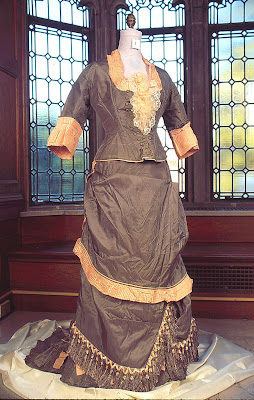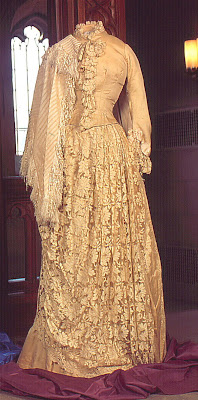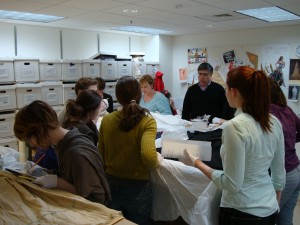As shown in our last video, this ensemble is an interesting case for stabilization, thanks to its (perhaps) upside down sleeve.
 |
| From 1992.003 |
Some notes:
Bodice: Ivory silk satin with gold and pink floral metallic brocade; pink silk ribbon; metal boning; metal hooks and eyes; pink synthetic lining; pink silk lining; white cotton grosgrain ribbon waistband;
Fitted brocade silk princess-seam bodice with modified puff sleeves with gathers at the underarm and longer at the bottom of the sleeve than the top, and square neckline. Open at front of interior panel brocade with pink ribbon lace-up closure w/ hand-stictched holes. Six-piece paneled back with slightly curved boat-neckline at back. 7 pieces metal boning in back interior and interior grosgrain ribbon waist tape with hook and eye closures at front. Two hooks at center back of waist tape (to connect to skirt). Synthetic additions at center interior front and hem of sleeves.
Skirt: ivory silk satin with gold and pink floral metallic brocade; starched pink cotton lining; pink silk lining; natural cotton lining; tan grosgrain ribbon; cream silk chiffon ruched trim
full gored brocade skirt with back fullness and room for pad(?); longer in back; pink piping around waistband under grosgrain ribbon; one pocket on right hip; 6 gored panels and 3 godets; cream silk ruched trim at hem and one 2.5 inches up from hem
Shoe: ivory silk satin with gold and pink floral metallic brocade; leather; gold (leaf?); natural canvas; brass nails; pressed wood
two pieces of brocade on exterior; double bow at toe cleavage; pointed toe; Louis heel shape; 9 nails into heel
label reads: “Robes de Bal / Russell & Allen / Old Bond Street LONDON” printed on inner waistband
“Mrs. Crosby” handwritten on small hand sewn tag“rip in fabric of bodice top right front, 2nd row of trim around hem partially detatched, fabric of skirt coming apart from waistband, silk of shoe worn on the back of heel and left side, interior silk lining of bodice shattered, original silk lining possibly entirely gone, leaving pink cotton lining unfinished interlining; natural linen original reinforcement for train safety-pinned to interior, pink synthetic additions to interior of bodice, brocade panel stolen from inside of skirt used as center front panel on bodice (because actors weren’t small enough?)
What do you think of it? Here’s a slideshow with more images:


